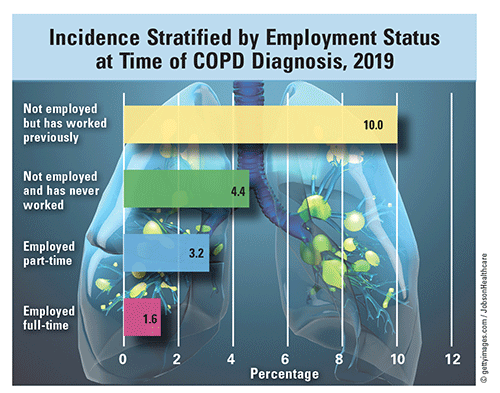US Pharm. 2021;46(7):14.
In 2019, according to the CDC, the fourth-highest cause of mortality in the United States (47.8 deaths per 100,000 population) was chronic lower respiratory disease. Recent data show that 14.8 million people have been diagnosed with chronic obstructive pulmonary disease (COPD; emphysema and bronchitis, both chronic and unspecified). It has been estimated that 75% of patients with chronic COPD are smokers or former smokers.

Statistics for Visits in Which Primary Diagnosis Was Made: Just over 8.1 million adults received a primary diagnosis of COPD during an emergency-department visit and 5.7 million were diagnosed during a physician office visit. At the time of diagnosis, 18.7% of patients had a disability. Female patients outnumbered males by 24.4% (5.1% of female patients vs. 3.2% of male patients were diagnosed). Payment sources for physician office visits in which the primary diagnosis of COPD was made included Medicaid (9.1); Medicare, including Medicare Advantage (8.7%); and private insurance (7.9%).
Education Level and Employment Status: Patients with higher educational levels were less likely to be diagnosed with COPD. Those with a college degree or higher (1.8%) had a 68% lower incidence rate than patients with some college education (5.6%), and those with a high school diploma or high school equivalency diploma (6.8%) had a 24% lower incidence than those who did not have a high school diploma (9%). There were some interesting findings in patterns of employment status at the time of the patient’s visit to the physician’s office when the diagnosis of COPD was made. The incidence was 127% higher in patients who were unemployed but had worked previously (10%) than in patients who had never worked (4.4%), whereas the incidence was lower in those who were employed part-time (3.2%) or full-time (1.6%).
Marital Status and Ethnicity: COPD was diagnosed most frequently in persons who were widowed (13.2%) and nearly one-third less often in those who were divorced/separated (9.1%). Diagnosis was higher in patients living with partners (diagnosis rate 4.4%) than in those who were married (3.8%). Disease was least often diagnosed in never-married patients (2.2%). Patients diagnosed with COPD were predominantly of non-Hispanic white ethnicity (diagnosis rate 5.6%), followed by American Indian (4.5%), non-Hispanic African American (3.8%), and Hispanic patients (2.5%); Asian patients, at 1.2%, had the lowest rate.
The content contained in this article is for informational purposes only. The content is not intended to be a substitute for professional advice. Reliance on any information provided in this article is solely at your own risk.
To comment on this article, contact rdavidson@uspharmacist.com.






